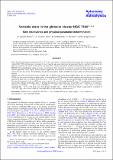Files in this item
Variable stars in the globular cluster NGC 7492 : new discoveries and physical parameter determination
Item metadata
| dc.contributor.author | Figuera Jaimes, R. | |
| dc.contributor.author | Arellano Ferro, A. | |
| dc.contributor.author | Bramich, D.M. | |
| dc.contributor.author | Giridhar, S. | |
| dc.contributor.author | Kuppuswamy, K. | |
| dc.date.accessioned | 2014-09-19T12:01:05Z | |
| dc.date.available | 2014-09-19T12:01:05Z | |
| dc.date.issued | 2013-08 | |
| dc.identifier | 149532514 | |
| dc.identifier | a0887e1d-51b2-49bd-b389-bb6fe008cf74 | |
| dc.identifier | 84879585157 | |
| dc.identifier.citation | Figuera Jaimes , R , Arellano Ferro , A , Bramich , D M , Giridhar , S & Kuppuswamy , K 2013 , ' Variable stars in the globular cluster NGC 7492 : new discoveries and physical parameter determination ' , Astronomy & Astrophysics , vol. 556 , A20 . https://doi.org/10.1051/0004-6361/201220824 | en |
| dc.identifier.issn | 0004-6361 | |
| dc.identifier.uri | https://hdl.handle.net/10023/5464 | |
| dc.description | A.A.F. acknowledges financial support from DGAPA-UNAM grant through project IN104612. The authors are thankful to the CONACyT (México) and the Department of Science and Technology (India) for financial support under the Indo-Mexican collaborative project DST/INT/MEXICO/ RP001/2001. | en |
| dc.description.abstract | Aims. We have performed a photometric V,R,I CCD time-series analysis with a baseline of about eight years of the outer-halo globular cluster NGC 7492 with the aim of searching for new variables and using these (and the previously known variables) to determine the physical parameters of interest for the cluster (e.g. metallicity, absolute magnitude of the horizontal branch, distance, etc.). Methods. We used difference image analysis to extract precise light curves in the relatively crowded star field, especially towards the densely populated central region. Several different approaches were used for variability detection that recover the known variables and lead to new discoveries. We determined the physical parameters of the only RR0 star using a light-curve Fourier decomposition analysis. Results. We found one new long-period variable and two SX Phe stars in the blue straggler region. We also present one candidate SX Phe star that requires follow-up observations. Assuming that the SX Phe stars are cluster members and using the period-luminosity relation for these stars, we estimate their distances as ~25.2 ± 1.8 and 26.8 ± 1.8 kpc, and identify their possible modes of oscillation. We refined the periods of the two RR Lyrae stars in our field of view. We found that the RR1 star V2 is undergoing a period change and possibly exhibits the Blazhko effect. A Fourier decomposition of the light curve of the RR0 star V1 allowed us to estimate a metallicity of [Fe/H]ZW ~ −1.68 ± 0.10 or [Fe/H]UVES ~ −1.64 ± 0.13, a log-luminosity log (L/L⊙) ~ 1.76 ± 0.02, an absolute magnitude MV ~ 0.38 ± 0.04 mag, and a true distance modulus of μ0 ~ 16.93 ± 0.04 mag, which is equivalent to a distance of ~24.3 ± 0.5 kpc. All of these values are consistent with previous estimates in the literature. | |
| dc.format.extent | 11 | |
| dc.format.extent | 1869726 | |
| dc.language.iso | eng | |
| dc.relation.ispartof | Astronomy & Astrophysics | en |
| dc.subject | Globular clusters: individual: NGC 7492 | en |
| dc.subject | Stars: variables: RR Lyrae | en |
| dc.subject | Blue stragglers | en |
| dc.subject | Stars: abundances | en |
| dc.subject | Stars: distances | en |
| dc.subject | Stars: horizontal-branch | en |
| dc.subject | QB Astronomy | en |
| dc.subject | QC Physics | en |
| dc.subject.lcc | QB | en |
| dc.subject.lcc | QC | en |
| dc.title | Variable stars in the globular cluster NGC 7492 : new discoveries and physical parameter determination | en |
| dc.type | Journal article | en |
| dc.contributor.institution | University of St Andrews. School of Physics and Astronomy | en |
| dc.identifier.doi | 10.1051/0004-6361/201220824 | |
| dc.description.status | Peer reviewed | en |
This item appears in the following Collection(s)
Items in the St Andrews Research Repository are protected by copyright, with all rights reserved, unless otherwise indicated.

